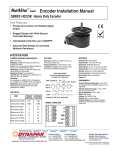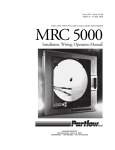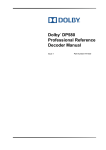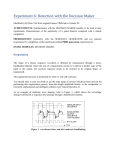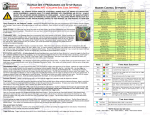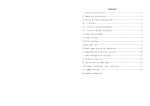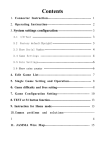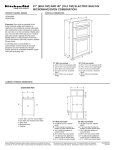Download NorthStar™ Encoder Installation Manual
Transcript
Headquarters: 1675 Delany Road • Gurnee, IL 60031-1282 • USA Visit us at www.dynapar.com Customer Service: Tel.: +1.800.873.8731 Fax: +1.847.662.4150 [email protected] Technical Support Tel.: +1.800.234.8731 Fax: +1.847.782.5277 [email protected] Encoder Installation Manual NorthStar™ brand SERIES EN44 Zone 1 “Hazardous Area” Rated Encoder Document No.: 702828-0001 Revision Level: A April. 2, 2012 Ex ia mb e IIC T4 Gb Certification No. Sira 09ATEX5172X 0518 General Application Environment The following instructions are meant to assist in proper installation of the NorthStar Series EN44 Sealed Hubshaft Encoder. The encoder is a harsh-duty speed and position transducer that when mounted to a rotating shaft, produces output pulses that are directly proportional to the shaft speed and direction. The encoder is attached to the motor shaft via a stainless steel flexible coupling that compensates for motor shaft end-play and run-out. The clamp is also electrically isolated from the encoder to ensure motor shaft currents do not ground through the encoder bearings. Due to this specialized coupling, special precautions must be taken during installation as outlined in this manual. The EN44 is uniquely designed with the primary protection technique as Encapsulation. The EN44 was designed specifically for “Hazardous Area” rated applications common in Oilfield operations. Proper operation is dependant upon installation by suitably trained personnel in accordance with the applicable code of practice. Care should be taken to inspect the shipping container and product for external damage and/or missing parts. If any is found, contact Dynapar immediately as well as the shipping agent. Tools Required for Installation Tool Caliper & Dial Indicator Gages 1/4" Hex Key Wrench 5/32" Ball End Hex Key Wrench Purpose Shaft Checks Shaft Clamp Access Plug Shaft Collar Clamp and Shaft Clamp Alignment Screw 3/16" Hex Key Wrench Encoder Mounting Screws 10mm Hex Key Wrench Stopping Plug Open End Adjustable Wrench Cable Gland 7/64" Hex Key Wrench Terminal Box Cover 1/8" Flat Blade Screwdriver Terminal Block Wiring Torque Wrench, 20–75 inch pound range Tightening Fasteners Threadlocker, Loctite 242 or equivalent Retaining Fasteners The encapsulated electronics and increased safety interface allow for use in Zones 1 and 2 with flammable gases and vapors with apparatus groups IIA, IIB & llC and with temperature classes T1, T2, T3, and T4. The equipment is only certified for use in ambient temperatures in the range –50°C to 100°C. Compliance with the Essential Health and Safety Requirements has been assured by compliance with the following documents: EN 60079-0:2006 (General) IEC 60079-0:2007 (General) EN 60079-7:2007 (Increased Safety) EN 60079-18:2004 (Encapsulated) Before installation or operating in a “Hazardous Area”, the installer must be trained and familiar with hazardous area installation and IEC/EN 60079-14 standards. Note: Encapsulation techniques are an improvement over "flameproof" 60079-1 Specifications requiring heavy XP metal enclosures to contain a flame. Encapsulation eliminates the air around the electronics preventing ignition and allowing smaller lightweight enclosures to be used in the design. Table of Contents Topic Page Description & Table of Contents ............................. 1 Electrical Installation ........................................... 2-3 Mechanical Installation ........................................4-5 Specifications ......................................................... 6 SIRA User Instructions ........................................... 7 SIRA Certification ............................................. 8-11 Declaration of Conformity ..................................... 12 Application Assistance 1.800.234.8731 (847.662.2666) Page 1 ELECTRICAL INSTALLATION CAUTION: Before installation, ensure power is off and locked out. Failure to do so may damage encoder and/or cause a spark or explosion. Electrical Installation must be performed by an individual that is trained and familiar with hazardous area installation. Standards that apply are IEC/EN 60079-14 and other applicable wiring codes that apply to the specific location of the installation. Please follow the guidelines for a type “e” Increased Safety Installation. Other cable considerations include flammability, temperature, chemical, etc as applies to the area and environment of installation. If in doubt see the IEC/EN60079-14 standard as applies to Increased Safety installations and local regulations. Important Wiring Instructions: Use shielded cable with a defined wire gauge per the following table. * Terminal blocks type ‘e’ certified for the conductor range: Connectable Conductor Cross Section Rigid/Soild Wire mm2 (AWG) Flexible/Stranded Wire mm2 (AWG) 0.14 - 2.5 (26-14) 0.14 - 1.5 (26-16) Consider the length of cable and desired drive currents for your application. Consider a 0.5mm2 or 20AWG cable as a minimum starting point. You can increase or decrease the wire diameter based on your specific application. SHIELDING – It is good wiring practice for a shield to be connected to signal-ground at the receiving device only. Connecting the shield at both ends can cause grounding (loops) problems that degrade system performance and give a path for stray currents to travel. EN Series Encoder Wiring Configuration with Fused Power CABLE PROTECTION - Run the encoder cable through a dedicated conduit (not shared with other wiring). Use of conduit will protect the cable from physical damage and provide a degree of electrical isolation. If a conduit is not practical use wire trays to protect cable. If there is not a practical way to protect the cable you may consider using armored cable - See section 9 of the IEC/EN60079-14 standard as applies to Increased Safety installations. Do not run the cable in close proximity to other conductors that carry current to heavy loads such as motors, motor starters, contactors etc. This practice can induce electrical transients in the encoder cable, potentially interfering with reliable data transmission. CAUTION: Unused encoder signal wires must be individually insulated and under no circumstances be in contact with ground, voltage sources, or other signal lines. Zone 1 Wiring Considerations CAUTION: The Encoder wiring configuration for the EN series encoder is different than an Intrinsic Safe wiring configuration. No IS barrier, Zener or Galvanic, is required when using the EN series encoder. Barriers may prevent proper operation and/or frequency performance. Damage to the encoder may occur if the encoder output is connected to an IS barrier. When selecting an encoder, consider the power supply to the encoder and input voltage to your data acquisition, PLC or drive system. Cable length and RPM max will determine which output driver option to select. The configurations below are examples of protected wiring practices and help to determine the best wiring scheme. EN Series Encoder Wiring Configuration with Fused Power and LED activity Lights LED/Fused Power Terminal Block 200mA max Suggested LED/Fused Power Terminal Block 200mA max Suggested Power Supply + - Acquisition A System AB BZ Z- Page 2 Typ - Standard Terminal Block Power Supply + Typ - Standard Terminal Block EN Series Encoder Acquisition A System A- EN Series Encoder B BZ Z- Application Assistance 1.800.234.8731 (847.662.2666) LED/Fused Terminal Block No Fuse Installed - for Indicator LED Only Cable Entry & Gland Selection This product is supplied with dual 3/4” NPT entry holes for wiring to the terminal block. SPECIAL CONDITIONS FOR SAFE USE (denoted by X in the certificate number) require cable entry to be fitted with an ATEX certified Type “e” cable gland. Any gland certified for use as Type “e” and matching the cable selected and designed to fit a 3/4” NPT can be used. Wiring Procedure Step 1: Remove terminal box cover. Assemble cable & gland per manufactures instructions. Step 2: Strip cable jacket back 3 inches. Strip individual leads back 0.35”. If ordered from Dynapar with no gland, customer must supply an appropriate gland. If ordered with one of our available glands, proper manufacturers assembly instructions must be followed. Refer to HAWKE assembly instructions included with your product, or locate and reference them on the HAWKE website: www.ehawke.com. Dynapar Available Glands. (ref. page 6 “Ordering Information” – Code 5) Code 1: Non-Armored Cable – HAWKE 501/421 A 3/4” NPT S Assembly Instruction: A1 307 / Issue M – 11/08 Code 2: Armored Cable – HAWKE 501/453/UNIV A 3/4” NPT Assembly Instruction: A1 300 / Issue M – 11/08 Signal and Wiring WAVEFORMS DATA AND INDEX Not all complements shown A shown for reference (180° ELEC (90° ELEC) Data A Data A Data B Index A leads B, CCW (From Clamp End) ELECTRICAL CONNECTIONS Encoder Function Terminal Box Connection Sig. A 1 Sig. A 2 Sig. B 3 Sig. B 4 Sig. Z 5 Sig. Z 6 Power +V 7 Com 8 Step 3: Wire to terminal block using pin assignment on this page or on the inside of terminal box cover. Carefully press a 1/8" flat blade screw-driver into the inboard hole to open terminal. Insert wire completely and remove screwdriver. Step 4: Replace terminal box cover. Application Assistance 1.800.234.8731 (847.662.2666) Page 3 MECHANICAL INSTALLATION STEP 1: Please reference the below diagram titled "EN 44 Motor Mount Requirements" to ensure that a correct mounting interface is provided for the mechanical installation of this encoder. The EN44 has a 0.110 inch piloted face that is concentric with the Flex Coupling. Be sure to create a concentric pilot with the six 1/4-20 inch threaded holes on customer equipment as shown in the diagram. CAUTION: Upon initial inspection of the shaft coupling area of the EN44 you will notice a 10-32 screw that extends through the encoder body and into the shaft coupling. DO NOT remove this Coupling Locating Screw until directed to do so in Step 9 of the Installation Procedure. STEP 2: Ensure the mounting interface and shaft extension are free of dirt, grease, or any other foreign matter. Check the shaft Total Indicated Run-out (TIR), and ensure that it does not exceed 0.005” TIR. Please familiarize yourself with the following as seen in the magnified view drawing below: 1. Shaft Clamp Screw STEP 3: Using the 1/4” hex key, remove the Shaft Clamp Access Plug from the side of the encoder body. 2. Shaft Clamp Access Plug 3. Flex Coupling Locating Screw STEP 4: Place the 5/32” ball end hex key into the access hole and loosen the Shaft Collar Clamp Screw. Place a small amount of threadlocker on the screw threads and re-install it into the Clamp Collar. Re-thread the screw into the clamp loosely. DO NOT TIGHTEN. Remove the 5/32” ball end hex key from the access hole. 4. Coupling Locating Hole Note: The encoder can be mounted on shafts of varying lengths (MIN 0.47 in, MAX 0.83 in). EN44 MOTOR MOUNT REQUIREMENTS STEP 5: Place a Lockwasher onto each 1/4-20 x 1” Encoder Mounting Screw (6 required). Apply a small amount of threadlocker to the screw threads. +.005 3.345 -.000 PILOT STEP 6: While observing the proper orientation of the cable exit, slide the encoder straight over the motor shaft extension, and engage the encoder's Flex Coupling. Note again, shaft engagement is MIN 0.47" MAX 0.83". 16MM OR 5/8" SHAFT .110 MIN. PILOT DEPTH .47 MIN. TO .83 MAX. SHAFT LENGTH 6X 1/4-20 X EQUALLY SPACED ON A 3.937 B.C. 0.70 MIN. EN44 COUPLING/CLAMP INSTALLATION Note: Please refer to this figure when performing Installation Steps 7 – 11. 1 SHAFT CLAMP SCREW 2 SHAFT CLAMP ACCESS PLUG 3 Page 4 4 COUPLING LOCATING HOLE FLEX COUPLING LOCATING SCREW Application Assistance 1.800.234.8731 (847.662.2666) MECHANICAL INSTALLATION Note: Please refer to ‘EN44 Coupling/Clamp Installation” figure (previous page) when performing Installation Steps 7 – 11. STEP 7: Install the six Encoder Mounting Screws using the 3/16” hex key and torque to 75 inch pounds. STEP 8: Using the 5/32” hex key, tighten the Shaft Clamp Screw. Torque to 36 inch pounds. Remove the 5/32” hex key. CAUTION: The motor shaft must NOT be rotated until Step 9 (below) is performed, or damage to the encoder flex coupling will result. STEP 9 Using the 5/32 hex key, completely remove the 10-32 x 1.5” Flex Coupling Location Screw. This screw is no longer needed for installation, instead replace with the shorter 10-32 x 7/8" screw. Obtain the 10-32 x 7/8” SHCS from the hardware kit (this screw has an o-ring under the head). Apply a small amount of threadlocker to the screw threads. Using the 5/32” hex key install the screw into the Coupling Locating Hole and torque to 20 inch pounds. The purpose of this shorter screw is to block the hole while in operation. STEP 10 Apply a small amount of threadlocker to 1/8” NPT Shaft Clamp Access Plug threads. Using the 1/4 hex key, install the plug and torque to 60 inch pounds. DIMENSIONS mm [inch] Application Assistance 1.800.234.8731 (847.662.2666) Page 5 SPECIFICATIONS STANDARD OPERATING CHARACTERISTICS MECHANICAL Code: Incremental Resolution: to 2048 PPR (pulses/revolution) See Ordering Information Format: Two channel quadrature (AB) with optional Index (Z, ungated), and complementary outputs Index: 180 degrees ±18 degrees (electrical), ungated Phase Sense: A leads B for CCW shaft rotation viewing the shaft clamp end of the encoder Quadrature Phasing: 1200 PPR: 90° ± 15° electrical; 2048 PPR: 90° ± 30° electrical Symmetry: 180° ± 18° electrical Waveforms: Squarewave with rise and fall times less than 1 microsecond into a load capacitance of 1000 pf Mechanical Interface: Stainless steel shaft clamp Mating Shaft Length: 0.47” to 0.83” (11.9mm to 28.1mm) Coupling: 16mm, flexible Shaft Speed: 6000 RPM, max. Bearings: 6107 Bearing life: 5 x 108 revs at rated shaft Loading, 5 x 1011 revs at 10% of rated shaft loading. (manufacturers’ specs) Housing Material: Aluminum Alloy, Black Anodized Disc material: Mylar® Weight: 6 lb. 6 oz, typical ELECTRICAL Input Voltage: 7-15VDC, 7-26VDC (see ordering information) Input Current: 65mA max., not including output loads Outputs: TC4428 Line Driver Output Current: (Refer to Ordering Information Table, Code 4: ATEX Output Format) Code 4 Option 0 or 2: 125mA max. per channel Code 4 Option 1 or 3: 10mA max. per channel @ 100°C; 15mA max. per channel @ 90°C Frequency Response: 125 kHz (data & index) Termination: Terminal block - Ex screwless w/spring cage-clamp Interface: HAWKE type “E” increased safety rated gland for armored and non-armored cables. HAWKE Part Numbers: Non-Armored Gland: HAWKE 501/421 A 3/4” NPT S (accepts 8.5 - 13mm cable, OD) Armored Gland: HAWKE 501/453 UNIV A 3/4” NPT (accepts 12.5 - 20.5mm cable, OD) ENVIRONMENTAL Operating Temperature: -50 to 100°C. See †Note Storage temperature: -50 to 100°C. See †Note Shock: 50G’s for 11msec duration Vibration: 5 to 2000Hz @ 20 G’s Humidity: 100% Enclosure Rating: IP67 † Note: Armored Gland high-temperature specification limited to +80°C. * Specifications subject to change without notice. All product and brand names are trademarks of their respective owners. All rights reserved. NorthStar™ brand is a trademark of Dynapar. All rights reserved. © 2012 Dynapar Mylar® is a registered trademark of Dupont Models Ordering Information To order, complete the model number with code numbers from the table below: Code 1: Model Code 2: PPR Code 3: Bore Size Code 4: ATEX Output Format Code 5: Termination EN44 Ordering Information EN44 ATEX Zone 1 Hubshaft Encoder 1024 2048 A 16mm 0 Differential AB, 7-15V in, 7-15V out 1 Differential AB, 7-26V in, 5V out 2 Differential ABZ, 7-15V in, 7-15V out 3 Differential ABZ, 7-26V in, 5V out 0 No Gland 1 Ex Gland for non-armored cables (8.5 - 13.5mm OD) 2 Ex Gland for armored cables (12.5 - 20.5mm OD) See †Note * See Electrical Specifications for Details † Note: Armored Gland high-temperature specification limited to +80°C. Page 6 Application Assistance 1.800.234.8731 (847.662.2666) SIRA USER INSTRUCTIONS 1. The certification marking is as follows: * Temperature ratings - The equipment is only certified for use in an ambient temperature range -50°C to +100°C. * The encoder is rated at IP54 for certification purposes. In order to achieve this level of protection, appropriate ATEX certified type ‘e’ Glands or Plugs must be used by the end user. The thread form of the cable entries is 3/4 NPT. 2. The equipment may be used in Zones 1 and 2 with flammable gases and vapours with apparatus groups IIA, IIB & IIC and with temperature classes T1, T2, T3 and T4. 3. The equipment is only certified for use in ambient temperatures in the range -50°C to +100°C and should not be used outside this range. 4. The certificate number has an ‘X’ suffix, which indicates that the certificate contains one of more special conditions for safe use. Those installing or inspecting the equipment should refer to this section of the certificate. 5. The equipment has not been assessed as a safetyrelated device (as referred to by Directive 94/9/EC Annex II, clause 1.5). 6. The equipment has not been assessed as a safetyrelated device (as referred to by Directive 94/9/EC Annex II, clause 1.5). * Terminal blocks type ‘e’ certified for the conductor range: Connectable Conductor Cross Section 0.14 - 2.5 [26-14] 0.14 - 2.5 [26-14] Rigid [mm2] (AWG) Flexible [mm2] (AWG) 0.14 - 1.5 [26-16] 0.14 - 2.5 [26-16] MAINTENANCE ISSUES * Periodic inspections should be made to ensure that there is not excessive play in the encoder shaft due to bearing wear or damage. Additional documentation provided with each unit: * Sira Certificate * Installation, NonBarrier #200872-0001 PREPARATION: Disconnect power from equipment and encoder cable. 7. Installation of this equipment shall be carried out by suitably-trained personnel in accordance with the applicable code of practice. Note: Ensure that pipe-thread tape or equivalent sealer is applied to the conduit entry stopping plug and mating cable gland for proper sealing. 8. Repair of this equipment shall only be carried out by the manufacturer or in accordance with the applicable code of practice. Position the anti-rotation arm at a 90 degree angle (Ideal) to the motor shaft. 9. The certification of this equipment relies on the following materials used in its construction: Enclosure: Case material type - Anodized aluminium. Other external parts and Shaft material: Aluminium or SST. Potting Compounds: Silicone Based Sealing Orings: Silicone type Shaft seals: Viton If the equipment is likely to come into contact with aggressive substances, then it is the responsibility of the user to take suitable precautions that prevent it from being adversely affected, thus ensuring that the type of protection is not compromised. This orientation ensures: * Minimal housing rotation and encoder error caused by relative motion. * Reduced misalignment of bearing rod ends to prevent binding and premature wear due to high degrees of misalignment. Do not disrupt the anti-rotation arm’s 90° alignment with the motor shaft during mounting. A parallel orientation between the anti-rotation arm and the motor shaft is not recommended because it will significantly reduce the anti-rotation arm’s performance and operational lifetime. Each rod end can withstand only 50° of deviation. Ideally, the anti-rotation arm should be mounted with rod-end ball centered in its socket. Recommended torque: 20 FT-LBS. [27 N-m]. “Aggressive substances” -e.g. acidic liquids or gases that may attack metals, or solvents that may affect polymeric materials. “Suitable precautions” - e.g. regular checks as part of routine inspections or establishing from the material’s data sheet that it is resistant to specific chemicals. Application Assistance 1.800.234.8731 (847.662.2666) Page 7 Page 8 Application Assistance 1.800.234.8731 (847.662.2666) Application Assistance 1.800.234.8731 (847.662.2666) Page 9 Page 10 Application Assistance 1.800.234.8731 (847.662.2666) Application Assistance 1.800.234.8731 (847.662.2666) Page 11 Page 12 Application Assistance 1.800.234.8731 (847.662.2666)












